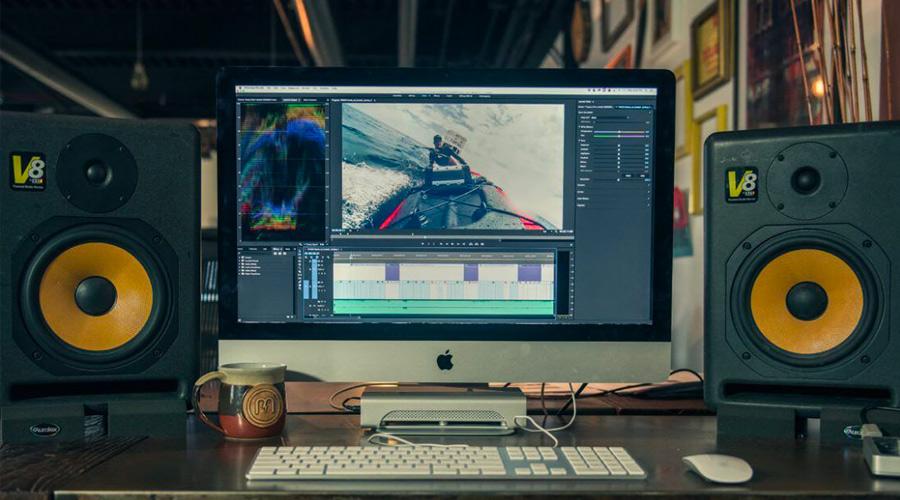At Magnetic, we have the most talented video department I’ve ever been a part of. Our nimble outfit is equipped to pull off all kinds of video, from high concept brand spots to straightforward product videos, commercials, event sizzles, even animated explainer videos. But one of the most engaging and in-demand video types we’re asked to do is the all-important talking head video.
Today, we’re going to teach you how to conceive, script, and produce a talking head video like a pro. And for those with experience creating talking head videos, your observations and suggestions are more than welcome. With each production we continue getting better.
Hold Up...
What is a Talking Head Video?
A talking head video is an interview-style video that uses subject matter experts to guide the story of a product, service, or event. While some talking heads are just interviewees on camera, at Magnetic we like to break things up with custom B-roll (more on that later). Here’s an example of a talking head video we produced in the past.
Want to drive influence through video marketing?
Find out how video can help you tell your story without speaking a word.
This customer success video for AVEVA created an emotional connection between the customer and the digital transformation company.
Talking Head Videos Speak Volumes
The value of talking head videos is manifold. Whether or not you place media dollars behind your content, there are numerous reasons for investing in this type of video, such as:
- Corporate brand communications: Speak directly to shareholders, customers, or internally to company employees.
- Public relations: Gain visibility for your brand and organization with a targeted message.
- Customer success stories: Think of it like a product or service testimonial where your brand is the hero within your customer’s business or life.
- Sales support: Humanize your sales message with a video directly from a company sales rep. This application makes a great icebreaker, putting a face to your pitch before ever meeting clientele.
- Explainer videos: Rather than relying on a straight voiceover to introduce your product or service, this type of application adds a personal touch to your explainer video.
Conceiving Your Talking Head Video
Like all video projects at MAGNETIC, we go in with the notion that we have a story to tell. The story may be grand and luxurious, or narrow and detailed, but it’s a story nonetheless. And like all great stories, it will have a structure that leads the viewer from a to b to c without feeling forced or rigid.
First, Make Sense of Your Videos Storyline
In a video where the narrative is guided by interviews, how do you plan and script a story when you don’t know exactly what people are going to say on camera? The answer (at least for us) is mapping out a loose story structure. The most basic story structure we use goes something like this:
 Exposition: An introduction to the subject and/or the interviewee.
Exposition: An introduction to the subject and/or the interviewee.
- Rising Action: Explaining the problem your brand’s product or service is designed to solve.
- Climax: The solution to the problem (AKA your brand).
- Resolution: The final message we want to drive home with the viewer.
I’ll be frank… not every single story you wish to tell is going to fit perfectly within this structure. Nor is this the only story structure out there, but it does provide a simple framework by which to conceive what the message and flow of your video could look like.
For example, let’s say you’re a wearable tech manufacturer releasing your newest heart rate wristband, the Trackmaster 2000. You have a charismatic Product Manager who would be great for an on-camera interview. A general story structure for your talking head video might be:
- Exposition: Today we’re introducing the newest product for athletes of all size, shape, and fitness levels: the Trackmaster 2000.
- Rising Action: With the rapid rise of personal health data, athletes everywhere are searching for a better way to understand their bodies during workouts.
- Climax: The Trackmaster 2000 is designed to optimize your workout knowledge and performance with remarkably accurate heart rate tracking and personalized feedback through our intuitive app.
- Resolution: Make every drop of sweat count with the Trackmaster 2000.
It ain’t Shakespeare, but do you get the point? With a little structure, your story has a clear narrative that can help to shape the production of your talking head video.
Related Reading:
Sizzle Video Marketing, a Guide to Budget, Reach & Impact
Scriptwriting for Talking Head Interview Videos
You might ask yourself, “If my video is going to be driven by interviews, why the heck do I need a script?” But here’s the thing...
We always aim to provide greater value than our prices, and in our experience, clients typically don’t take well to the idea of “Well, we’re gonna go in there with some cameras, ask a few questions, and figure it out along the way. Then we’ll bill you.” Frankly, it’s just not a responsible way to execute video productions.
Instead of a spray and pray approach, developing a loose script helps clients understand that our intended outcome addresses their goals for the video. It also gives advance notice to the interview subjects of the type of questions they’ll be asked come production day.
Good Questions = Useful Answers
Once you have a general idea of your story, next comes the interview script.
At MAGNETIC, we’ll start by writing a master list of questions and prompts designed to elicit relevant answers. Depending on the subject matter, these can range from very simple, straightforward questions, to more complex and technical questions. Let’s stick with the Trackmaster 2000 as an example…
In the Rising Action portion of our story, we want our interview subject to summarize the problem their product or service is designed to solve. So, we might ask questions like:
- What trends are you seeing in the wearable tech space that may interest athletes?
- How has tracking fitness metrics changed in the last 5-6 years?
- Why is it so important for athletes to track their workouts?
- What kind of health metrics are athletes paying attention to?
- Until this point, why has it been so difficult for athletes to track their workouts precisely?
The goal is to develop questions that focus your interviewee on the right answer. Once you’ve developed that master list, you’ll drop it into a script template.
A Script Template for Talking Head Interview Videos
Depending on the number of interviews to be featured in a talking head video, scripts can grow fairly complex, but for simplicity’s sake, here’s a stripped down example of how we might structure a talking head video script for the Trackmaster 2000.

As you can see, we’ve developed a list of questions to support the narrative. It’s important to sequence the questions in the right order. Not only does it keep the conversation linear, it also helps to save time during post-production when you’re selecting sound bites that drive the narrative forward.
*Download a free Word template for talking head interview scripts*
Want more Copywriting Tips?
Check out our 3 Simple Copywriting Tips to Enhance Your Branded Content Today
Producing a Clean, Comfortable Interview for Your Talking Head Video
Your interview subject is ready, your cameras are rolling, and you have a handy interview script in hand. Now what?

Start with a Few Ground Rules
Your job as an interviewer is to keep your subject comfortable, confident, and focused, but something happens when people sit down in front of the camera. The whole room falls quiet, bright lights are beaming down on them, and the pressure starts to set in. Which is why every video interview I’ve conducted at Magnetic starts with a few ground rules to help my subject settle in.
Please turn your cell phone to silent.
You don’t want an amazing answer to be interrupted by a buzzing phone.
As I ask you a question, try to repeat some of that question in your answer.
For instance, if I ask ‘What’s your name?”, don’t just respond with “Joanna”. Instead say “My name is Joanna.”
It’s not your voice that will drive the video forward. It’s theirs. When you go back to cut the video together, it’s much easier to create a cogent narrative when your interviewee gives context to the subject they’re discussing.
Don’t worry about being perfect.
If you stumble on a word, if you need a moment to think, or if you ever want to return to add more depth to an answer, just let me know. That’s the beauty of the editing bay. We’ll make you sound perfect in the end.
This is an important one. It reassures your interviewee that they’re in control. The pressure to deliver the perfect answer is off, and from here on out, it’s just a conversation between you and them.
Aim for Authentic Answers
By now your interview subject should have had access to the questions you’ll ask. If not, that’s okay, and sometimes it actually works to the video’s benefit.
Like this example we did for Nexgrill’s Beyond the Flame branded content series, where fly-fishing guide Maddie Brenneman responded to questions without any prep. (This video’s narrative is driven by interviews while the visuals are almost 100% B-roll.)
Want to see more?
See all of Nexgrill’s Beyond the Flame videos produced by MAGNETIC
In my experience, the best interviews happen when the subjects speak and respond naturally. Their attention is focused, their passion comes out, and they don’t sound rehearsed.
You don’t want an interviewee to script out everything they say. Unless you’re working with a professional actor, scripted answers can tend to feel stiff, forced, or too corporate. One time I had an interview subject who blew up their answers on poster board so they could read them word for word. Suffice to say, it didn’t go well.
If you run into someone who’s scripted or memorized their answers, first let them run through a few. If it’s going well, that’s great. Keep on trucking. If it feels too rigid though, pause the interview, politely ask them to have a drink of water, and remove their answer sheet. You’ll be surprised. When people speak off the cuff, their answers are typically more thorough, natural, and convincing.

A Few Tips on Conducting a Successful Talking Head Video Interview
Treat it like a conversation.
It’s paramount to keep your subject at ease. The more they feel this is a conversation, the more rhythm and comfort they’ll establish.
Don’t be afraid to go off-script.
It’s important to get through all of your preconceived questions, but in the course of discussion, they may say something that prompts a new question you never thought of. When that happens, dig in. Ask for more detail.
The fewer people on set, the better.
The more people in the room, the greater the chance your subject gets distracted.
It’s hard getting people comfortable on camera.
If another subject matter expert, stakeholder, or client is in the room, and they’re interrupting or coaching the interviewee on what to say, let it happen… but only to an extent. Once they’ve given their input, reset the interviewee with a question that helps them articulate the answer in their own words.
Ask your question, and shut up.
As interested as you may be in the subject matter, it’s nearly impossible to cut together an interview video when you’re interjecting with conversational niceties like “mm hmm” or “oh right”. An easy way to indicate you’re listening is to nod along, smile, and mirror your subject’s body language.
Not everything has to be a question.
You can start by stating exactly what you want your subject to say, and follow with a simple “Tell me about that”, or “Expand on that idea for me.”
This isn’t journalism.
In talking head videos for brands, it’s okay to ask leading questions like, “Why do you feel the Trackmaster 2000 is an athlete’s best friend?”
Those with experience being interviewed understand that you’re looking for concise sound bites with plenty of meat on the bone.
However, some people give long-winded explanations. Too long for your video. If this happens to you, kindly say this… “This is an important question. For the sake of editing, I’d like to try that again. This time, see if you can cut it down to 15 seconds.” And then ask your question again.
Listen with an editor’s ear.
Once in a while, your subject is going to say something absolutely perfect. When they’ve finished, take a brief pause, and mark it on camera with a big clap.
Writing a Post-Production Time Stamp Script
You nailed the interview. The client is thrilled with the production. Now it’s crunch time. All that hard work you put in will amount to zilch if you can’t bring it all together. Here’s what to do…
Get Your Talking Head Interviews Transcribed
A proper transcription with time stamps is worth its weight in gold. A transcription is a written document showing you who said what during which times. You can use this to time stamp each portion of the interview so your editor isn’t pulling their hair out trying to locate and isolate a specific sound bite.
There are several great services out there that can transcribe your video for cheap. At Magnetic, we love Rev. We’ve also used One-Hour Translations for international productions. Or for projects with a really tight budget, we might upload the interview privately to YouTube, which has a decent transcription function for free. You can also develop your own transcription, although it’s a time and labor-intensive task.
Extract the Best of the Best & Time Stamp
Pop some popcorn and watch the uncut video from start to finish, reading along with your transcription. Highlight all of the areas where you got a good response, and drag them into a master file to size up what you’re working with. With your master file, you can start cutting down and rearranging to weave together a story. If you’re unsure where to start, use your original story structure as an outline.
Be brutal when editing.
You may wind up with 20 minutes of answers to one topic, but your final video will only spend 20 seconds of time on that portion of the narrative. As you go through each line deciding what to keep and what to discard, ask yourself a few questions:
- Is this sound bite critical to advancing the video’s narrative, or just added flavor?
- Is there a specific sound bite that works well for the video’s introduction and conclusion?
- If there are multiple interviews, are the right people covering the right topics?
When you have your storyline in a good place, use the original transcript to give each sound bite a time stamp. This will help your video editor quickly find and extract the right interview segments to build out the story.
Use Voiceover & On-screen Text to Patch Holes
I confess, there have been several instances while reviewing an uncut interview where I said to myself, “Damn it, Jeff! You forgot to ask about this.” or “You should’ve pressed them further about this point.” If that happens to you, remain calm. It’s not the end of the world or your client’s project.
If the information you failed to acquire is absolutely critical, there are a couple of tools you can use to patch up your mistakes during the interview:
- On-screen text. Not only can on-screen text help to patch or transition from point to point, it can also really emphasize an important message.
- Let’s say there’s something your subject struggled to articulate, or your client comes back after video production with an additional point they’d like to include. You can use voiceover to clearly articulate what isn’t covered during the talking head video.
- Voiceover is also a great way to tighten up the structure of a video with a simple exposition and a powerful resolution.
A Quick Note on The Value of B-roll
I cannot overstate the value of good B-roll.
B-roll is supplementary footage inserted as a cutaway to help tell the story. It keeps your video from dragging on, and your viewers from disengaging and clicking through to something else.
Think about the last time you watched an interview video that was purely shots of people. You probably can’t recall it because you either stopped watching 30 seconds in, or you died of boredom and clicked over to a sweet video of a veteran reuniting with their dog.
While the narrative of your talking head video is driven by an interview, good B-roll drives greater engagement, and helps to fill out your talking head video with compelling visuals. Whether you film your own or opt for stock footage, maintain some budget for good B-roll.
That’s a Wrap
Talking head videos provide a ton of support and versatility for large corporations, small businesses, public relations, sales, and B2B communications. You can use them to simplify complex offerings, explain detailed processes, feed social media channels, introduce new products, or simply to humanize your brand.
Making a great talking head interview video might sound complex, but we at Magnetic have our method down pat. With a little story structure, a practiced production team, and a full-scale engagement team on the back end, not only can we create talking head videos, we can also set them into action for the maximum impact.
If you have need for a talking head video or you’ve created your own and think we can improve our method, we’re always open for a conversation. Give us a shout to get in touch with one of the most talented video departments in branding today.




Join the Discussion